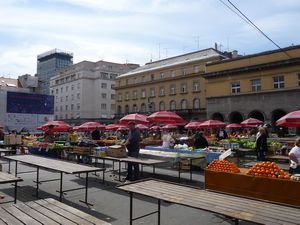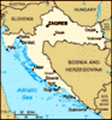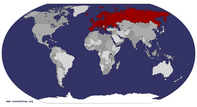Advertisement
Published: November 13th 2010

 P1050260
P1050260
Zagreb marketplaceMy Croatian journey is off to a fantastic start. I did, however, have to return to the hostel to get a pen that works to complete that opening sentence so hopefully that is not a bad omen. It's Tuesday evening and my stay in Zagreb is coming to a close. I will catch a train tomorrow down the Dalmatian coast to Split. This is a very appropriate time and place for me to begin this journal as I find myself sitting on a bench at the top of a hill overlooking the city. The view rivals that of anything that I have come across in my travels.
I am not surprised that Zagreb is a beautiful place--most European capitals are. To find such unbelievable beauty, comes as quite a shock to me. It is depressing to think that communism, like it did to so many other great cities, hid this gem from the world for a generation.
The clock just struck 6:30 and the gong of the bell tower below at the cathedral has alerted me to the setting sun. It's twin steeples and massive size dominated the skyline. The white granite and gold clock are set aflame as

 P1050262
P1050262
Zagreb Cathedralthe sun descends behind me. The cathedral is surrounded by a U-shaped stone wall that surely stood as a defensive barricade throughout history. The red tile roofs below make it impossible to make out where the streets are. Having walked them, I know that the cobblestone lanes run parallel to one another and form a terrace down to the base of the hill where you find Tkalciceva Ulica, the street where I am staying. It's lined with restaurants, cafes and bars and is no doubt the popular hangout for young people. On the far side of the street, and directly in front of me is a beautiful yellow baroque church equipped with a bronze domed clock tower. The bronze is finely decorated in gold. The setting sun has now transformed the granite cathedral into a soft pink color and the gold statue of the mother Mary in the cathedral's square has caught the light. Behind the statue, and closer to me, is the city's marketplace. The open square is reserved for what appears to be a daily operation. With Easter fast approaching, the market was full of decorative eggs and other spring crafts along with a wide variety of fruits,
vegetables, nuts and other local products. Observing a market is an excellent way to learn about the customs and culture of a country. The tables, products and vendors arrive early to set up shop and clean house by early afternoon. Everything is long gone by now.
In the distance, behind the cathedral, the light fixtures of the football stadium can be seen. Dinamo Zagreb is a fixture in European competition and the staium's size is a testament to their success. I walked by ther today on my way to the city park, easily one of the largest in Europe, if not the world. It is incredible and features a zoo and several ponds along with miles of walking trails through the wooded forest. One of the ponds that I happened upon was home to more turtles than I have ever seen in my life.
7pm and the bell tower sets off a symphony throughout the city. I feel like I am in a medieval city, and I am, but Zagreb's combination of old and new is what makes it truly unique. From where I sit all one can see is the old but just to the south is

 P1050276
P1050276
Bem SquareBem Square, the city's modern center. It is here that Zagreb's busy streets and tram lines converge. The buildings are covered in advertisements as many are under renovation. The rooftops are adorned with large neon letters. The southwest corner of the square features a skyscraper (for European standards).
The fine people at Wikipedia have described Zagreb as a mixture of Prague, Budapest and Vienna and throw in a taste of Italy. Having been to these destinations, I can say they have the right idea. The more I traevl, the less I like to rank one place over another. Every city is unique and has its strengths and weaknesses. With that being said, I can see a lot of Prague in this city. The red roofs, gothic/baroque churches and narrow cobblestone alleys remind me of the Golden City. It is much smaller, though, and there is less to see. It is also missing one key component to Prague and Budapest--a river. Zagreb has the Sava (the same river that flows through Slovenia) to the west, but the river is off in the distance and seems to form the border of the Old Town and New Zagreb, the industrial city. It

 P1050336
P1050336
View from the hill.is certainly not a central feature of the city. Most European cities have done a nice job industrializing without damaging the ambiance of the old city, and Zagreb appears to be no exception. I'm not sure where the comparisons to Budapest are coming from. Zagreb is certainly much cleaner and greener, a huge knock against my hometown. The Italian influence is certainly here but I can't exactly put my finger on it. The city lies at the foot of a large ski mountain to the north and the red roofs, terraced streets and warm weather (at least today) plays tricks on your mind. I half expected to stumble onto the Adriatic while exploring these last couple of days. Although Zagreb lacks the palaces of Vienna, its vast array of museums and long green parks and fountains reminds me a bit of the Austrian capital. My conclusion, though, is that Zagreb is a city unto itself and really a beautiful place.
Zagreb is certainly a cultural city. I don't think I have seen more outdoor seating at cafes and restaurants anywhere else in Europe and it's only the end of March.
The neon roof advertisements down below at Bem

 P1050357
P1050357
Saint Mark'sSquare have just come on and the city prepares for night. The street my hostel is on will soon spring to life as the younger crowd heads out to grab a beer. Unfortunately I'm on a tight budget and will be going to bed early. I sampled one of the national brews yesterday and was unimpressed. There is a microbrewery not far from my hostel that serves some pretty good beer. Medvedgrad Pivnica is definitely Na Zdravi material if we choose to have a Croatian representative. I hope to sample more beer as well as Croatian cuisine as I journey south to the coast. The trip has been great so far. I am staying in a crappy little hostel but I have my own room with a little twin bed. It's all I need and it is places like this that allow me to do what I love to do--and that is travel.
The cathedral is all lit up now, even it's skeleton steeples. It's 7:30 now. I plan on taking one final walk around the hill district behind me before heading in for the night.
...
Well, walking around the hill district turned into one more

 P1050378
P1050378
Park Gategiant loop around the city. I just can't get enough. It's 15 degrees tonight so the streets are filled with people walking around or having drinks at outdoor cafes.
Another nice thing about this city is the lack of Americans. I say this slightly joking of course but I am deeply disturbed by what is happening to Prague as it becomes a top tourist destination. I know that Croatia has embarked on an ambitious tourism advertising campaign in recent years. I remember watching them on SkyTV in Prague and wondering what the hell there was to see in Croatia. "The Mediterranean as it once was" is their slogan. I shall find out its truth in the coming days. So far, I'm very impressed. I have seen quite a few tourists, though. Don't be fooled, just not too many English speakers. The level of English here seems to be higher than in Hungary. When buying food at a shop all I have to say is "hi" and the cashier will give me the price and say goodbye in English. It's funny--everywhere I go, I want to speak Hungarian. "Koszi" and "Bocsi" (thanks/sorry) are ingrained in my mind but do me
absolutely no good here or anywhere outside of Hungary. The Croatian language is Slavic so it has some similarities to Czech. I know enough Czech to find familiar words in grocery stores and on signs but I also know enough to be able to tell that a Czech would have a very difficult time understanding things here. It's very easy to spot the difference between a Slavic language and Hungarian although I think the jury is till out on which is harsher on the ear. As I sat on the Croatian/Hungarian border for about an hour, I detected the Croatian language as soon as the border guard came on board, even before I saw them. The inspection was more thorough than I imagined and slightly ridiculous. Two Hungarians (a police officer and a customs officer) asked for my passport, where I was going and whether I had anything to declare. This was immediately followed by two Croatians asking the exact same questions. It is the border of the Schengen Zone, though, so I can understand why they take it so seriously. The fact that Europeans are able to travel so freely is made possible by such inspections.
The train
ride through Hungary was beautiful. It was a sunny and clear morning and the train took us all the way down the southern shore of Lake Balaton. The lake is the largest in central Europe and the top tourist/summer destination for Hungarians. I can understand why. The small towns that dot the lake have great nostalgic appeal. Many towns seem to be stuck in the early 20th century. The train stations and summer camps do not look like they have changed in the last hundred years.
Advertisement
Tot: 0.061s; Tpl: 0.014s; cc: 12; qc: 30; dbt: 0.0261s; 1; m:domysql w:travelblog (10.17.0.13); sld: 1;
; mem: 1.1mb













